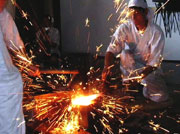| The History of Bizen Osafune |
The Bizen area of western Okayama has always been known for its iron production.
The township of Osafune also lies at the intersection of the Yoshiigawa
River and the old Sanyo road (from Tokyo to Hiroshima.) The marketplace
was in the district known as Fukuoka, and it was a bustling hive of activity.
The city of Fukuoka on the island of Kyushu takes its name from here.
Swords were produced here for more than 1000 years, through the Heian,
Kamakura, Muromachi and Edo eras. More than 2200 master swordsmiths are
listed in the Muromachi Era "kotouki documentüh alone. Today, many
of the swords produced in Osafune are listed as national treasures and/or
important cultural assets.
|
 |
Traditional swordsmiths at work
(Courtesy Osafune Sword Museum) |
Our ancestors invested their lives in the production of these swords, pouring
their souls into endlessly hammering out masterpieces. But nature was not
kind to them. In August of the 18th year of the Tensho period heavy rains
caused the Yoshiigawa to burst its banks, flooding the township. A landslide
on Mt. Kumayama at the same time exacerbated the destruction. 1200 homes
were destroyed and more than 7000 people lost their lives.
390 years later, their spirits were invoked with the establishment of Meito
Daiko in 1988. The three part performance piece "Requiem for the Swordsmiths"
composed by Higashi Munenori tells their story;
 |
1, Fukuoka no Ichi (The Markets of Fukuoka) |
 |
 |
2, Yama Tsunami (The Landslide) |
 |
 |
3, Fukkatsu eno Tsuchioto (Hammering Towards Rebirth ) |
 |
|
|